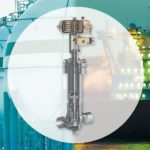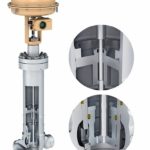Cryogenic liquefied gases are stored and transported at very low (cryogenic) temperatures and, if necessary, high pressures. To maintain these conditions, the employed valves must have a special design. The materials used to manufacture wetted components, such as the valve body and trim, must be capable of withstanding the extreme temperatures of the process medium, which may drop to near absolute zero. Even after longer periods in service, the materials must show no signs of embrittlement.
In terms of appearance, cryogenic valves stand out from other valves due to their long insulating section or extension bonnet, which creates the necessary distance between the valve body that carries the process medium and the valve bonnet. This cryogenic extension bonnet ensures that the cryogenic process medium does not damage sensitive components. To prevent an exchange of energy between the inside of the cryogenic valve and the warm environment, cryogenic valves are often insulated (e.g. in offshore installations) or mounted in a so-called ‘cold box’. These installation specifications make it difficult to access the valves. As a result, working on them is time consuming and complicated, which calls for low-maintenance designs with a long service life.
Even stricter requirements apply to cryogenic valves used as throttle valves in gas liquefaction. If gases are liquefied using turbines and/or valves, the process takes advantage of the Joule-Thomson effect. This means that the gases are depressurised below their inversion temperature, which causes them to liquefy – contrary to their behaviour above the pressure-dependent inversion temperature. Joule-Thomson valves are expected to handle high pressure drops between the compressed medium at the valve inlet and the relieved medium at the valve outlet. Severe pressure differences across the valve favour the occurrence of cavitation and flashing. This results in high noise levels, severe vibrations and erosion on valve components.
For larger volume flow rates
For many decades, Samson has been developing and manufacturing cryogenic valves in compliance with applicable specifications. Different valve versions in small and medium sizes for moderate pressure drops at cryogenic temperatures were added to the product range long ago. With the newly developed Type 3598 valve, Samson responds to the trend that has also taken hold of the industrial processes to produce and distribute cryogenic gases: plants are becoming ever larger while constantly higher flow rates and differential pressures need to be handled. During the development process, Samson brought together the thorough on-site experience gained over many years by plant operators with the corporate know-how acquired through CFD (computational fluid dynamics) simulations and experiments conducted at Rolf Sandvoss Innovation Center. The product management and R&D departments focused on reducing the total cost of ownership by achieving greater reliability, ease of service and energy efficiency.
More reliability
The Type 3598 valve for cryogenic process media is capable of handling high pressure drops and also available in large valve sizes. This makes the valves suitable for operation in up-scaled process plants with high flow rates as well as for use as Joule-Thomson valves in applications with high pressure drops and, consequently, a risk of cavitation. In larger valve sizes, there is enough space downstream for the flow to continue without disturbances despite cavitation and flashing. To minimise undesired vibration and imminent cavitation damage on the sealing surfaces inside the valve, the pressure is let down in the clamped-in cage and not at the seating surface, as is the case in valves with seat-plug design.
Ease of service
The cryogenic valve has a top-entry design. This design comes with a single-piece valve body including a large-diameter cryogenic extension bonnet. As a result, service and maintenance work on the trim parts can be performed without having to remove the valve from the pipeline, cold box or insulation. After the actuator has been disassembled, there is free access to the valve seat, piston and circulation inhibitor through the cryogenic extension bonnet. The pressure balancing assembly fitted as standard guarantees that even large control valves are easy to service and disassemble. This is because relatively little force is required to move the piston, even in large control valves and at high pressure drops. As a result, smaller actuators having a lower weight can be mounted on the valves. As a positive side effect, it is also possible – depending on the valve size – to fit actuators suitable for the direct attachment of positioners or limit switches. This considerably reduces the piping and hosing required for installation.
Higher energy efficiency
A circulation inhibitor is installed in the lower part of the cryogenic extension bonnet, which influences the process medium’s temperature distribution across the insulating section. This offers several advantages: no icing up of the packing chamber, which is located in the valve bonnet outside the cold box or insulation. And no heat energy from the outside can heat up the process medium, which has been cooled down with great effort. The interface between the cold box and the environment can additionally be insulated by attaching an optional cover plate to the valve. So, the control valves’ total energy balance is influenced by the optimised temperature conditions as well as the required air capacity. On top, the thrust needed by the actuator plays an important role, which means that the included pressure balancing has a positive effect as well.
Lower actuator thrust
Due to the engineered design, the cost of purchasing a Type 3598 cryogenic valve is higher than a standard valve with screw-on insulating section. This is counterbalanced by the lower cost resulting from the lower actuator thrust and smaller actuator size required. Realistically, it would be possible to use an actuator with 1000 cm² diaphragm area on a pressure-balanced valve instead of a 2 x 2800 cm² actuator on an unbalanced valve of the same size. A comparison of the two actuators shows a reduction of roughly 90 % concerning travel volume and weight and of around 80 % when it comes to the actual cost of the actuator.
Outlook
Further versions of the cryogenic valves with enhanced features are already in the pipeline. This includes modular additions – such as larger valve sizes and higher pressure ratings – as well as angle-style valve bodies. Currently, the valves are available according to Ansi standards only, but DIN versions will follow.
Samson AG, Frankfurt, Germany
Authors:
Martin Knaack
Product Management & Technical Sales,
Control Valves Solutions,
Samson
Timo Maus
Product Management & Technical Sales,
Control Valves Solutions,
Samson
Andreas Sander
Research & Development,
Modular Systems & Severe Service Applications,
Samson








